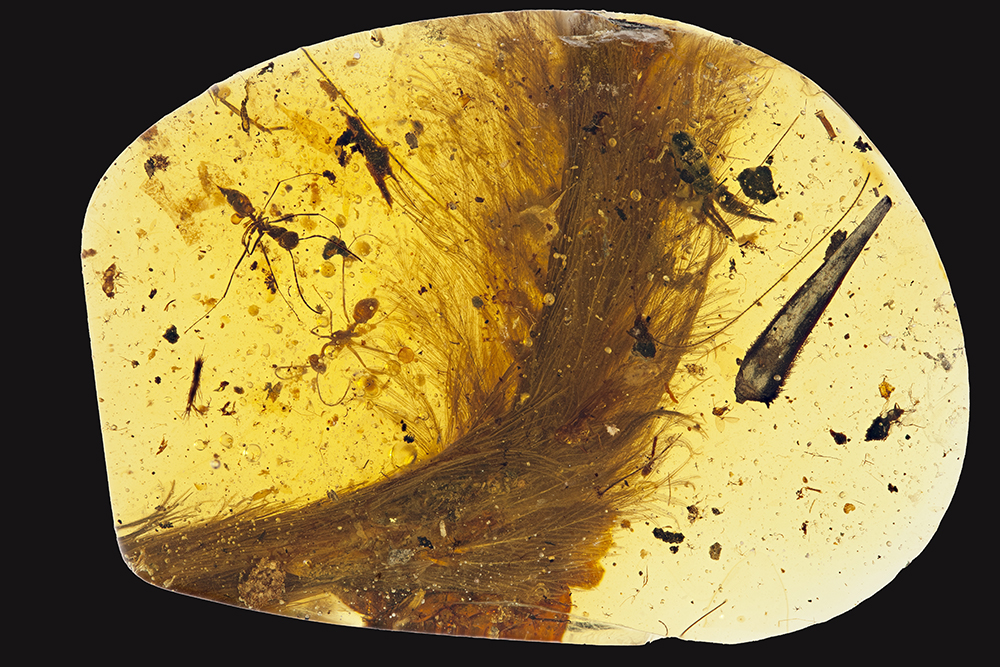PermeateFree said:
mollwollfumble said:
Word of the day “dinofuzz”, the fuzzy protofeathers found on dinosaurs such as Sinosauropteryx and kulinandros.
http://www.sciencemag.org/news/2011/09/dinofuzz-found-canadian-amber
from link:
When Ryan McKellar, a paleontologist at the University of Alberta in Canada, and his colleagues searched through more than 4000 bits of amber in Canadian museum collections, they found 11 specimens that included remnants of feathers and protofeathers. The largely transparent chunks of amber—most of them smaller than 1 centimeter across—had been pulled from coal deposits laid down about 78 million or 79 million years ago, when the region, then near sea level, was a wetland covered with conifer forests.
which made me wonder. Australia has coal – could some of them have amber nodules of the right age for dinofuzz, or older or younger fossils?
Some amber has been found in Qld, but this is only a few million years old.
Many Australian black coal deposits such as from Wollongong are made from Glossopteris from the Permian era. Any sign of amber or similar from our black coal fields?
There is a similar substance, not amber but “coal resin” or “copal” from the Lal Lal and Yallourn brown coal fields in Victoria. This is solid resin that has not fossilised into amber. Victorian coal fields range in age from 40 Ma to 10 Ma years ago. The resin is found in reasonably large quantities, and it seems to me that it could be searched for trapped fossils. Que?
Australia has conifers, but I don’t think it has had forests of them since we were part of Antarctica and even then probably only in Tasmania and Victoria. It would depend I think as to the type of vegetation that was around at the time, so you would need a list of dominant vegetation and their capacity to produce resin. Don’t think amber is common in Australia as it is in some European countries where they can find it washed up on the beaches.
- – - – - – - – - – - – - – - – - – - – - – - – - – - – - – - – - – - – - – - – - – - – - – - – - – -
North Qld amber: presumed Miocene, kauri-derived (Agathis sp.). This was the first report of in-situ amber in Australia.
http://www.create.unsw.edu.au/downloads/godthelpetal_beijing_2010.pdf
- – - – - – - – - – - – - – - – - – - – - – - – - – - – - – - – - – - – - – - – - – - – - – - – - – -
I have personally logged many tens of thousands of metres of Permian, Jurassic and Cretaceous coal in serious detail. Only once have I seen amber. I kept and still have the specimen. I had intended to write it up, but life got in the way. Lower Jurassic, Surat Basin, several yellow spheroids around 0.5 mm across, in coal.
I have neither seen nor read of amber in Permian or Cretaceous coals.
Interestingly, pebbly sandstones in the Jurassic Surat Basin sequence commonly have silicified wood lumps and tree trunks in them, likely kauri (Agathis sp). So don’t discount the possibility of some amber turning up should the proposed big mines in the Surat Basin go ahead (seems unlikely now though). I note (sadly), that amber has not been reported from any of the currently active Surat Basin coal mines. Unfortunately, amber discovery potential away from mines is very low, as the ocean doesn’t intersect the Surat Basin coal measures, so low-oxidation, high-mechanical-intensity erosion doesn’t happen.
The upshot is that even if amber were common, it would likely be oxidised before erosion. To give you some idea of the rate of erosion in the Surat Basin, silicified (Agathis sp) wood in the pebbly sandstones is more often than not completely replaced by iron oxides. Erosion is so slow, silica is dissolved and replaced by iron oxides.
